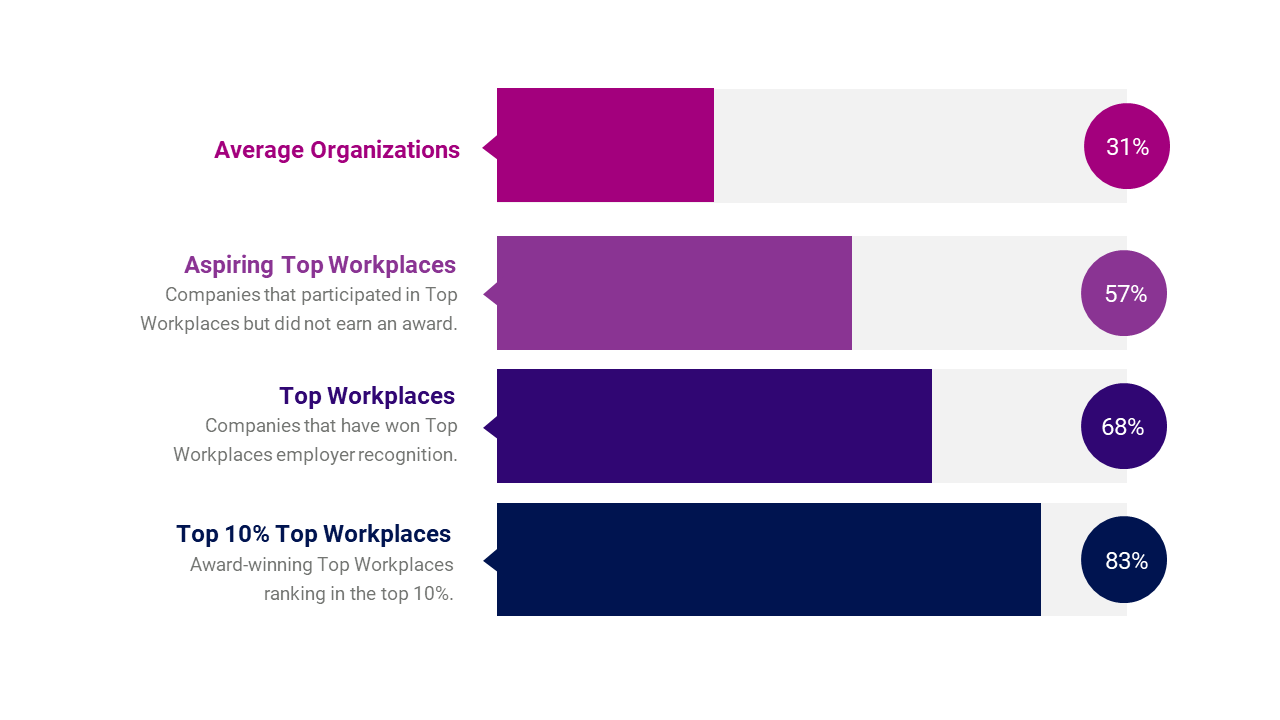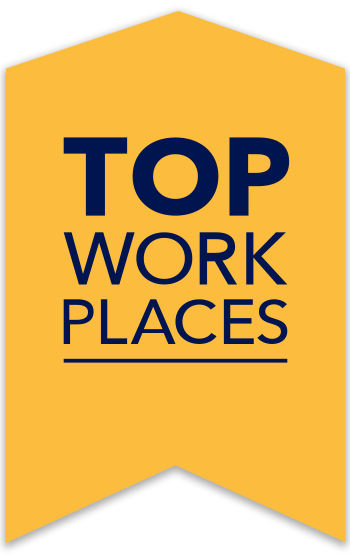Improve Employee Engagement with Top Workplaces
Discover our proven strategies for a top-tier work culture
by Top Workplaces
by Top Workplaces | Employee Engagement
Improving Employee Engagement
There’s more to employee engagement than free lunches, happy hours, and take-your-dog-to-work day. The fact is, engagement can be tough and it requires leadership buy-in to move the needle. But why is employee engagement important? It’s the best way to limit unwanted turnover, boost productivity, and increase your referral rate. Not to mention, a lack of employee engagement is one of the top reasons why employees quit and is a major sign of a bad company.
Of the 70,000 organizations Energage has researched, we know Top Workplaces have more than double the rate of engaged employees (68 percent) compared to average organizations (31 percent). And at the top 10 percent of Top Workplaces, this number jumps to an incredible 83 percent. Even aspiring Top Workplaces – the companies that participate in the program but do not win – exceed the U.S. average employee engagement level at 57 percent.
The truth is, there are many different definitions and signs of employee engagement. But at Energage, we choose to define it as “individual passion working toward shared success.”
Data-Driven Employee Engagement Strategies
Successful employee engagement strategies rely heavily on honest, anonymous employee feedback. First, it answers the ever-present need for employees to feel heard and safe. Second, it provides organizations with the insights they need to make people-informed decisions.
“The employee engagement survey has been an extremely helpful tool for us. We can have observations, but the survey bears them out. The numbers don’t lie.” Jeanne Lynch, Vice President of Human Resources, Griffis Residential
The Energage Workplace Survey – the same engagement survey used to determine the nation’s Top Workplaces – assesses several factors, including 15 research-based culture drivers and three statements that measure employee engagement:
- Commitment: “I have not considered searching for a better job in the past month.” For someone to be considered engaged, they should plan on staying with their organization. 71 percent of employees at Top Workplaces responded positively to this statement, while only 62 percent of employees at average organizations said the same.
- Referral: “I would highly recommend working at this company to others.” When an employee is willing to stake their reputation on your organization, that shows they feel trust, pride, and commitment. At Top Workplaces, 88 percent of employees agree. But just 79 percent at average organizations are willing to refer their friends and family.
- Motivation: “This company motivates me to give my very best at work.” When employees are motivated, they see themselves as part of a team. 81 percent of employees at average organizations rated this statement positively. Yet at Top Workplaces, this number leaps to 88 percent. That’s a lot of unleashed potential!
Employees who respond positively to all three of these statements have passion, energy, and commitment. They’re engaged, and they’ll go above and beyond for great places to work like your organization. Top Workplaces have clearly cracked the code.

Engagement at Average Organizations vs. Aspiring and Top Workplaces Organizations
Build Engagement Using Employee Survey Insights
In addition to measuring employee engagement and determining Top Workplaces employer recognition awards, the survey provides organizations with valuable insights that empower leaders to make people-first, data-driven decisions.
Successful employee engagement programs are informed by qualitative, objective data. These insights help organizations identify opportunities for improvement, build on strengths, and pivot when needed.
Survey insights can also be leveraged to attract top talent. Featuring employee feedback and culture strengths on your careers page is a great way to build your employer brand and give job candidates a glimpse of what it’s like to work for your organization.
Top Workplaces participants have a competitive edge because they can compare their results to similar companies based on size, industry, and role. They use these benchmarks to compare themselves to top-performing organizations over time.
Additional Benefits of Top Workplaces Participation
If you’re wondering how to improve employee engagement, becoming an aspiring Top Workplace is an excellent start. Organizations that participate in credible employer recognition programs experience benefits beyond the clear positives of improving company culture, including:
- Valuable survey insights to inform data-driven people decisions.
- Attracting the right talent with better employee recruitment efforts.
- Minimizing unwanted employee turnover and improving employee retention.
- Build a strong reputation and employer brand.
- Improved business outcomes and a return on investment.
“Top Workplaces is the only program that allows you to issue just one survey to be considered for employer recognition and also identify any possible organizational bumps in the road so you can proactively address them before they negatively impact employees, customers, and ultimately your bottom line.” Megan Koontz, Director of HR at Fusion Alliance
Building a healthy company culture that supports employee engagement takes work and perseverance, but the rewards are well worth the effort. You can also look to Energage for guidance and support. Our experts can help you to:
- Plan your strategy and tactics for putting activities into motion
- Provide action planning based on survey insights
- Brief your senior team on employee engagement survey results
- Facilitate training and change workshops
- Help with internal communication efforts

Get Recognized as a Top Workplace!
Enter your email address to nominate your organization.
